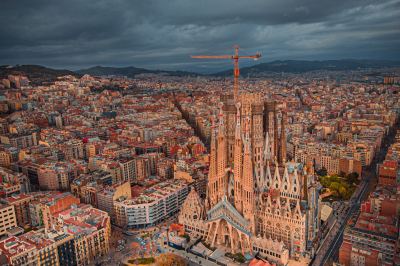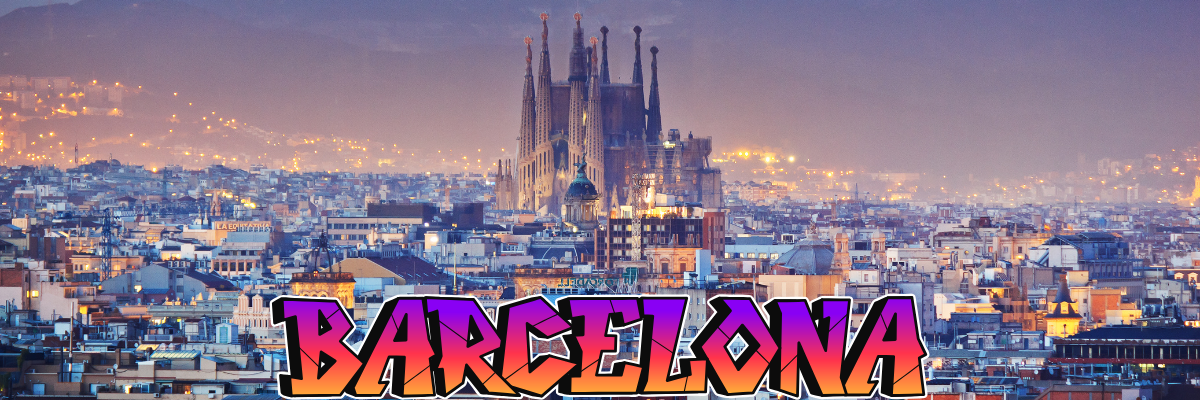Welcome to LetsVoyaj’s vibrant guide to the must-see things to do in Barcelona, where every corner pulses with art, history, and endless Mediterranean charm. From Gaudí’s awe-inspiring masterpieces to sun-soaked beaches and bustling market stalls, this city offers an unforgettable tapestry of experiences for every traveler.
Whether you’re marveling at the soaring spires of La Sagrada Família, wandering the winding alleys of the Gothic Quarter, or savoring tapas at Mercat de la Boqueria, Barcelona promises adventure at every turn. Let’s dive into the heart of Catalonia’s crown jewel and uncover the best experiences that will spark your wanderlust and leave you wanting more.
1.Experience Gaudí’s Splendor at La Sagrada Família

Antoni Gaudí’s unfinished masterpiece represents the pinnacle of Modernist architecture. Construction began in 1882 and continues today, with completion expected around 2026. The basilica’s exterior features intricate facades depicting the Nativity and Passion of Christ, while the interior astounds visitors with soaring columns designed to resemble a stone forest, with light filtering through stained glass windows in a rainbow of colors.
The geometric precision and natural inspirations throughout the structure reveal Gaudí’s mathematical genius and spiritual vision. Visitors should book tickets well in advance and consider the audio guide to fully appreciate the symbolism and architectural innovations.
2.Discover Whimsical Mosaics in Park Güell

Another Gaudí masterpiece, this public park was originally conceived as a residential development but later transformed into a municipal garden. The park showcases Gaudí’s signature style with organic shapes, colorful mosaics, and integration with the natural landscape. The famous mosaic salamander (known as “el drac”) greets visitors at the entrance, while the undulating bench encircling the main terrace offers panoramic views of Barcelona and the Mediterranean.
The park blends architectural elements with nature in a way that feels both whimsical and harmonious, demonstrating Gaudí’s belief that architecture should mirror the natural world.this elevation makes transportation planning important. Here’s a comprehensive guide to reaching this iconic park.
3.Journey Through Barcelona’s Gothic Quarter

The historic heart of Barcelona dates back to Roman times and features a labyrinth of narrow medieval streets and atmospheric squares. As you wander through this pedestrian-friendly district, you’ll encounter the impressive Barcelona Cathedral, hidden plazas like Plaça del Rei and Plaça Sant Felip Neri, and remnants of the ancient Roman city walls.
The quarter houses numerous small shops, traditional bars, and restaurants where you can sample authentic Catalan cuisine. The area comes alive particularly in the evening, when locals and visitors gather at outdoor terraces to enjoy tapas and local wines.
4.Stroll Along La Rambla & Dive Into Mercat de la Boqueria

La Rambla is Barcelona’s most famous boulevard, a tree-lined pedestrian street stretching from Plaça de Catalunya to the Columbus Monument at Port Vell. This vibrant promenade bustles with street performers, flower stalls, and outdoor cafés. Along this cultural artery, you’ll find the magnificent Gran Teatre del Liceu opera house and the entrance to Mercat de la Boqueria, one of Europe’s finest food markets.
Inside the market, colorful stalls display an astonishing variety of fresh fruits, vegetables, seafood, meats, cheeses, and local specialties like jamón ibérico. The market offers both a feast for the eyes and an opportunity to sample authentic Catalan gastronomy.
5.Admire Casa Batlló on Passeig de la Gràcia

Located on the elegant Passeig de Gràcia boulevard, Casa Batlló represents another of Gaudí’s architectural masterpieces. This extraordinary building, redesigned by Gaudí in 1904, features a façade that appears to be made from skulls and bones (the balconies) and is topped with a roof resembling a dragon’s back.
Inside, the building continues to surprise with its absence of straight lines, marine-inspired details, and ingenious use of light. The surrounding Passeig de Gràcia itself deserves exploration as Barcelona’s most luxurious shopping avenue, home to additional Modernist buildings like Casa Milà (La Pedrera) and high-end boutiques.
6.Ascend Montjuïc Hill for Panoramic Views

Rising prominently above the city’s southwestern edge, Montjuïc Hill offers a delightful escape from urban bustle while providing some of Barcelona’s most important cultural institutions. Visitors can ascend via cable car for spectacular panoramic views of the city and Mediterranean Sea.
The hill houses the impressive National Art Museum of Catalonia (MNAC), featuring one of the world’s finest collections of Romanesque art. The area also contains the 1992 Olympic facilities, the Magic Fountain that performs choreographed water shows set to music and lights, beautiful botanical gardens, and Montjuïc Castle, an old military fortress with centuries of history.
The various attractions are connected by peaceful walking paths through lush gardens, making Montjuïc perfect for combining cultural experiences with natural beauty.
7.Sunbathe at Barceloneta Beach & Port Olímpic

Barcelona uniquely combines urban sophistication with seaside relaxation. Barceloneta Beach, the city’s most popular and accessible stretch of sand, lies just minutes from downtown. This vibrant beach offers golden sands, beach volleyball courts, outdoor gym equipment, and numerous chiringuitos (beach bars) serving refreshing drinks and seafood. The wide promenade is perfect for walking, jogging, or cycling along the Mediterranean.
Adjacent to the beach, Port Olympic was developed for the 1992 Olympics and now houses upscale restaurants, nightclubs, and a large marina filled with luxury yachts. The area is anchored by the iconic twin skyscrapers Hotel Arts and Torre Mapfre, with Frank Gehry’s massive golden fish sculpture (“El Peix”) glimmering between them—a modern landmark that has become symbolic of Barcelona’s coastal identity.
8.Attend a Concert at Palau de la Música Catalana
This breathtaking concert hall, designed by architect Lluís Domènech i Montaner and completed in 1908, represents one of the world’s most extraordinary performance venues and a masterpiece of Catalan Art Nouveau (Modernisme). The Palau’s facade features intricate mosaics, sculptures, and floral motifs, but the true marvel awaits inside.
The main concert hall is dominated by an enormous stained glass skylight resembling an inverted bell, surrounded by sculptures of muses and Valkyries. Every surface contains decorative elements in stone, ceramic, and glass, creating an atmosphere of magical splendor. Even if you cannot attend a performance, guided tours reveal the building’s architectural and acoustic brilliance. UNESCO recognized the Palau’s cultural significance by designating it a World Heritage Site in 1997.
9.Ride the Rides at Tibidabo & Visit the Sacred Heart Church

Perched atop Tibidabo Mountain, the highest point of the Collserola Ridge, this unique destination combines century-old amusement park charm with spectacular views and spiritual significance. The Tibidabo Amusement Park, opened in 1901, is one of Europe’s oldest functioning parks, featuring a blend of historic rides (including a museum-worthy carousel and Ferris wheel) and modern attractions.
Adjacent to the park stands the striking neo-Gothic Temple of the Sacred Heart (Temple Expiatori del Sagrat Cor), crowned by a massive statue of Christ with arms outstretched toward the city below. Visitors can take the funicular railway or the vintage Tramvia Blau (Blue Tram) up the mountain, experiencing a nostalgic journey before reaching the summit that offers the most comprehensive views of Barcelona, the Mediterranean, and the surrounding mountains—a truly breathtaking perspective that reveals the city’s geographic context.
10.Discover Picasso’s Early Masterpieces at the Picasso Museum
The Picasso Museum in Barcelona (Museu Picasso) houses one of the most extensive collections of artworks by Pablo Picasso, the influential 20th-century Spanish artist. Located in five adjoining medieval palaces in Barcelona’s La Ribera neighborhood, the museum showcases over 4,000 works, primarily from Picasso’s formative years and early career.
The museum was established in 1963, following Picasso’s own wishes and with donations from his secretary and friend Jaume Sabartés. What makes this collection particularly special is its focus on Picasso’s developmental period between 1890 and 1904, showing his artistic evolution from academic training to his revolutionary Blue Period. The collection includes rare complete series like “Las Meninas” (1957), where Picasso reinterpreted Velázquez’s masterpiece in 58 paintings.
The historic buildings themselves, dating from the 13th to 15th centuries, add a distinctive charm to the visitor experience, with stone courtyards and Gothic arches providing a striking contrast to Picasso’s modern works. The museum stands as a testament to Picasso’s deep connection to Barcelona, where he spent his formative years and considered his artistic home.

